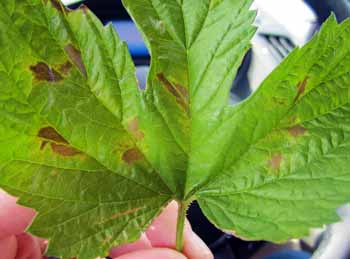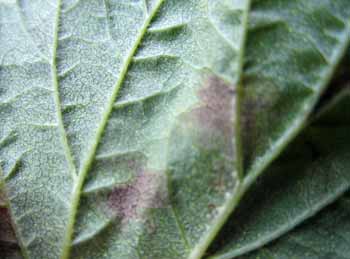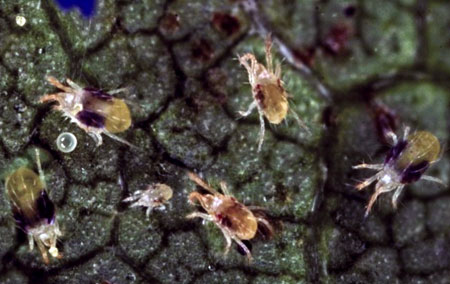Michigan hop update – June 6, 2013
Downy mildew and potato leafhoppers have arrived in Michigan hopyards.
Hop development continues rapidly with trained bines in northwest Michigan measuring 6 to 7 feet. Growing degree day (GDD) accumulation remains significantly different along the western portion of the state where the majority of hop acreage is located. So far this season the Benton Harbor Enviro-weather station has accumulated 556 GDD50 with 0.56 inches of rain over the past week; the Clarksville Enviro-weather station has recorded 479 GDD50 with 0.31 inches of rain; and the Northwest Michigan Horticultural Research Center accumulated 381 GDD50 with 0.67 inches of rain over the last week. Some training is still underway in northwest Michigan with growers doing some shallow cultivation for weed control. Growers are also reporting fertilizer applications based on tissue and soil tests. For more information on soil and tissue testing call your Michigan State University Extension county office or visit the MSU Soil and Plant Nutrient Laboratory website.

Hop development in northwest Michigan on June 4, 2013. Photo credit: Erin Lizotte, MSU Extension
Some growers have reported applying protectant fungicides for downy mildew prevention and reports of downy mildew symptoms are beginning to come in. Downy mildew is caused by Pseudoperonospora humuli and can cause significant yield and quality losses depending on variety and when infection becomes established. In extreme cases, cones can become infected and the crown may die.
Typically, downy mildew appears early in the season on the emerging basal spikes. Spikes then appear stunted, brittle and distorted. Asexual spore masses appear fuzzy and black on the underside of infected leaves. As bines continue to expand, new tissue becomes infected and fails to climb the string. Growers can attempt to retrain new shoots, but often incur yield loss as a result.


Angular downy mildew lesions that have dried down due to dry weather. Left photo show the front of the leaf, right photo shows the back. Photo credit: Erin Lizotte, MSU Extension
The causal agent of downy mildew overwinters in dormant buds or crowns, moving into buds during early spring and then moving into the tissue of the basal spikes as shoots expand. The pathogen produces copious spores on the underside of infected leaves. According to “A Field Guide for Integrated Pest Management in Hops,” infection is favored by mild to warm temperatures (60 to 70 degrees Fahrenheit) when free moisture is present for at least 1.5 hours, although leaf infection can occur at temperatures as low as 41 F when wetness persists for 24 hours or longer.
It takes a multipronged approach to manage for downy mildew. Growers should utilize a protectant fungicide management strategy to mitigate the risks of early and severe infections. Growers should keep in mind that varieties vary widely in their susceptibility to downy mildew and select the more tolerant varieties when possible. Clean planting materials should be selected when establishing new hopyards since this disease is readily spread via nursery stock. It is also recommended that growers pull all basal foliage during spring pruning. Pruning should be performed as late as possible and all green materials should be removed from the hopyard and covered up or burned.
When environmental conditions favor downy mildew development, cultural practices alone are not enough to manage the disease. Protectant strategies are particularly important during the year of planting to minimize crown infection and limit disease levels in the future. Well-timed fungicide applications just after the first spikes emerge and before pruning has been shown to significantly improve infection levels season long. Subsequent fungicide applications should be made in response to conducive environmental conditions (temperatures above 41 F and wetting events). Fungicides containing copper, boscalid, pyraclostrobin, phosphorous acids and a number of biopesticides have varying activity against downy mildew. Many growers also utilize sulfur-based products as protectants.
Michigan growers have yet to report significant powdery mildew damage, but given the experiences of hop growers around the U.S. growers should keep an eye out for this potentially significant pathogen.
Growers should also carefully monitor their hops for potato leafhopper populations as this insect has arrived throughout Michigan in the last week. Potato leafhoppers move in all directions when disturbed, unlike some leafhoppers that have a distinct pattern of movement. Potato leafhoppers can’t survive Michigan’s winter and survive in the Gulf States until adults migrate north in the spring on storm systems. Although hop plants are susceptible to potato leafhoppers, they can tolerate some level of feeding and growers should be conservative in the application of insecticides. At this time, there is no set economic threshold for potato leafhopper in hops.
Potato leafhopper feeding on hops causes what growers have termed “hopper burn,” which causes necrosis of the leaf margin in a v-shaped pattern and may cause a yellowed or stunted appearance as well. Scouting for potato leafhoppers should be performed weekly as soon as leaf tissue is present to ensure detection early and prevent injury. More frequent spot checks should be done following rain storms that carry the first populations north.
The easiest way to observe potato leafhoppers is by flipping the shoots or leaves over and looking for adults and nymphs on the underside of leaves. Growers may also chose to place two-sided yellow sticky traps in the field to catch potato leafhoppers.

Potato leafhopper on yellow sticky trap caught in a northwest Michigan hopyard this week. Photo credit: Erin Lizotte, MSU Extension
The most common classes of insecticides recommended for control of potato leafhoppers include the pyrethroids and neonicitinoids. Pyrethroids are effective at controlling potato leafhoppers and remain relatively inexpensive. However, pyrethroids have been shown to cause increases in mite populations in other crops and should be used judiciously, particularly early in the season when mite populations have time to build over the season. Neonicitinoids are longer-lasting and narrow-spectrum, making them a solid choice for management. Pyganic is an OMRI-approved insecticide organic growers might consider for potato leafhopper management.
Growers continue to scout for mites and despite activity in tree fruit, no activity has been reported or observed in hopyards yet this season. Two-spotted spider mites are a significant pest of hops in Michigan and can cause complete economic crop loss when high numbers occur by decreasing the photosynthetic ability of the leaves and causing direct mechanical damage to the hop cones. Two-spotted spider mites feed on the liquid in plant cells, eventually causing visible symptoms. Leaves take on a white appearance and will eventually defoliate under high pressure conditions. Intense infestations weaken the plant and reduce yield and quality. Infested cones develop a reddish discoloration, do not hold up to the drying process, and commonly have lower alpha levels and shorter storage potential. Additionally, the mites themselves act as a contaminate issue for brewers.
In the spring, only female two-spotted spider mites are present as they have overwintered in a dormant stage from the previous season and are already mated and ready to lay fertilized eggs. She appears particularly orange in color this time of the year and has overwintered on debris and trellis structures in the hopyard. As temperature warm, the females feed and begin laying eggs. Larvae emerge from the eggs in two to five days, depending on temperatures, and develop into adults in one to three weeks – again, depending on temperature. Two-spotted spider mites like it hot with the pace of development increasing until an upper threshold around 100 F is reached. Conversely, cold and wet weather is not conducive to development.
Two-spotted spider mites are very small, but can be observed on the underside of leaves using a hand lens. As the season progresses, cast skins and old webbing give infested leaves a dusty and dirty appearance. The eggs look like tiny clear spheres and are most commonly found in close proximity to adults and larvae. The larvae themselves are small, translucent versions of the adults which begin the season with a distinctly orange hue that changes over to translucent, yellow or green as they feed. Adults also have two dark spots.
When you are observing the underside of leaves, keep an eye out for beneficial, predatory mites that actually feed on two-spotted spider mites. Predatory mites are often translucent, larger than two-spotted spider mites and move at a much faster speed across the leaf surface. Predatory mites play an important role in balancing the two-spotted spider mite population and should be protected when possible.

Two-spotted spider mite eggs, larvae and adults (the adult females are the largest followed by the males). Photo credit: David Cappaert, Michigan State University, Bugwood.org
Growers should be scouting for mites now and remember that only when mites reach an economically significant level should cultural and chemical intervention be considered. Scouts should take leaf samples from 3 to 6 feet up the bine; as the season progresses, samples should be taken from higher on the bine as the mites migrate upward. Use a hand lens to evaluate two leaves from 20 plants per yard. Thresholds developed in the Pacific Northwest have established that more than two adult mites per leaf in June indicate the need to implement a pest management strategy. By mid-July, the threshold increases to five to 10 mites per leaf. Remember that if cones are not infested, hop plants can tolerate a good deal of damage from mites.
There are many factors that can affect the prevalence of mites in a given season, including the presence of beneficials, rainfall and temperatures. Consider selecting insecticides that have a minimal effect on beneficial insect populations and do not apply pesticides for mite control unless absolutely necessary as one application often necessitates continual applications in the absence of beneficial predators. Specifically, pyrethroid applications have been shown to increase in mite populations in the hopyard due to their negative impact on beneficial insects.
Growers should read and follow all pesticide labels carefully and proceed with caution when utilizing new materials.



 Print
Print Email
Email
